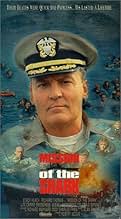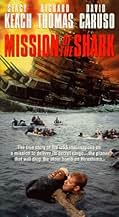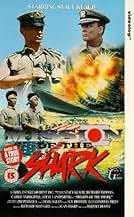Missão Tubarão: A Saga do Navio Indianápolis
Título original: Mission of the Shark: The Saga of the U.S.S. Indianapolis
AVALIAÇÃO DA IMDb
6,3/10
1 mil
SUA AVALIAÇÃO
Adicionar um enredo no seu idiomaTrue story of the sinking of the U.S.S. Indianapolis, its crew's struggle to survive the sharks and exposure, and the captain's scape-goat court-martial.True story of the sinking of the U.S.S. Indianapolis, its crew's struggle to survive the sharks and exposure, and the captain's scape-goat court-martial.True story of the sinking of the U.S.S. Indianapolis, its crew's struggle to survive the sharks and exposure, and the captain's scape-goat court-martial.
- Direção
- Roteirista
- Artistas
Joseph Carberry
- Spilner
- (as Joe Carberry)
Avaliações em destaque
A true story worth telling, this movie suffers heavily from contrived dialog which was obviously written by someone unfamilar with the Navy. It's a classic example of writers who have learned most of what they think they know about their subject matter from watching previous movies which were just as likely written by still other writers who learned from watching still earlier movies, ad infinitum. The use of an Iowa-class battleship to portray an obsolescent pre-war heavy cruiser less than one-third its size didn't help, either.
One technical point: speaking as a former submariner and current submarine museum director, speed was always generally regarded a significant defense to submarine attack, and given the technology available at the time it was just plain bad luck as much as anything else that the Japanese were actually able to hit the INDIANAPOLIS. Note also that the submarine had to fire a total of six torpedoes to achieve two hits.
One last point: speaking as the survivor of a vicious wild-animal attack, I can attest that the fear of it is infinitely worse than its physical reality, and I could easily come up with a long list of worse ways to go - surely one would suffer worse from dehydration and exposure, to say nothing of what the medical profession is capable of doing to you once you get to a hospital.
***SPOILER ALERT *** Incidentally, McVay never recovered from the sinking. He committed suicide in 1968. In 2000 the United States Congress passed and the President signed a formal resolution exonerating him from blame for the sinking.
One technical point: speaking as a former submariner and current submarine museum director, speed was always generally regarded a significant defense to submarine attack, and given the technology available at the time it was just plain bad luck as much as anything else that the Japanese were actually able to hit the INDIANAPOLIS. Note also that the submarine had to fire a total of six torpedoes to achieve two hits.
One last point: speaking as the survivor of a vicious wild-animal attack, I can attest that the fear of it is infinitely worse than its physical reality, and I could easily come up with a long list of worse ways to go - surely one would suffer worse from dehydration and exposure, to say nothing of what the medical profession is capable of doing to you once you get to a hospital.
***SPOILER ALERT *** Incidentally, McVay never recovered from the sinking. He committed suicide in 1968. In 2000 the United States Congress passed and the President signed a formal resolution exonerating him from blame for the sinking.
An accurate portrayal of the sinking of USS Indianapolis and worthwhile for telling a tale of survival under the most desperate conditions which can be imagined. Also the most damning indictment of leadership failure since Tennyson's Charge of the Light Brigade.
It was my misfortune, and that of the US Navy, that I viewed this production less than 3 days before I was to report to RECTRACOMGLAKES to begin what I expected to be my naval career. My confidence in the superiors appointed over me was shattered, particularly in Officers O-6 and above who might be reasonably expected not to misplace something as substantial as a heavy cruiser. My service was short, to my regret.
As for the court-martial of CAPT C.B. McVey, the practice of choosing a scapegoat in the aftermath of preventable disaster causing great loss of life appears to be endemic in the USN. Decades later, in the wake of the gun turret explosion aboard USS Iowa, naval investigators fabricated a fantastic tale of 'gay romance run amok' as the cause.
In the near twenty years gone by I hope that things have improved in the Navy. Most, enlisted and officers alike serve with great dedication and professionalism. Unfortunately a few bad apples spoils the barrel.
jHh
It was my misfortune, and that of the US Navy, that I viewed this production less than 3 days before I was to report to RECTRACOMGLAKES to begin what I expected to be my naval career. My confidence in the superiors appointed over me was shattered, particularly in Officers O-6 and above who might be reasonably expected not to misplace something as substantial as a heavy cruiser. My service was short, to my regret.
As for the court-martial of CAPT C.B. McVey, the practice of choosing a scapegoat in the aftermath of preventable disaster causing great loss of life appears to be endemic in the USN. Decades later, in the wake of the gun turret explosion aboard USS Iowa, naval investigators fabricated a fantastic tale of 'gay romance run amok' as the cause.
In the near twenty years gone by I hope that things have improved in the Navy. Most, enlisted and officers alike serve with great dedication and professionalism. Unfortunately a few bad apples spoils the barrel.
jHh
Other than a mention about the mission of the Indianapolis in Spielberg's "Jaws", many people have never heard of the sacrifice made by the men who delivered the atom bomb, before it's final, inevitable destination in Hiroshima. The horrors of war are of course often portrayed in film, but man vs. nature is a rarer occurrence in war movie history. The scapegoat portrayal of Keech's character should remind us all that being in command is quite often more of a burden, than an honour. War history buffs should check out this flick, as it is well worth your while.
I saw this film when it was first aired... Since then I have been interested in the story of the tragedy. This book has recently been published about the sinking, "In Harm's Way: The Sinking of the USS Indianapolis and the Extraordinary Story of Its Survivors" by Doug Stanton. I recommend this book to anyone who would like to know the complete story with the most current information. This will probably be the last book with new interviews from survivors as source material.
This film is nicely filmed, though probably purposefully has the feel and look (and dialog) of a movie made in the 50s or 60s. Since the beginning and end are set in the 60s, I suspect that it was done on purpose. Scenes on the Indianapolis are fairly well done. The acting is a little stiff throughout, which is mostly due to a rather dry, stiff dialog and unimaginative script. They do manage to get the viewer steamed up at the Navy at the Court Marshall of Captain McVay. The film leaves a bit to be desired, but the saddest part of the tale is that the horror is true and teh abhorent behavior of the US Navy was unforgivable, even as of 1991. I have no idea whether the record or memory of McVay has been cleared since, but it certainly should be. The film makes a strong statement about the horrible costs of war.
Você sabia?
- CuriosidadesThis is the very mission that Quint (Robert Shaw) talked about being a member of in a famous scene from Jaws (1975).
- Erros de gravaçãoIn the scene where a seaplane lands at sea to rescue the crew, the plane used is a Grumman Albatross. However, this aircraft was not put into service until 1949. The real life aircraft that rescued the crew, was a Catalina PBY.
- Citações
Hashimoto: Captain. You are a man who believes in fate?
Capt. Charles Butler McVay: No. I'm a man who was trying to accept it.
Hashimoto: It is not easy being a survivor.
- Cenas durante ou pós-créditos(Contents of Title Card 1) Following the U.S.S. Indianapolis tragedy the U.S. Navy discontinued its policy of not reporting arriving non-combat ships.
- ConexõesEdited from Enola Gay: The Men, the Mission, the Atomic Bomb (1980)
Principais escolhas
Faça login para avaliar e ver a lista de recomendações personalizadas
Detalhes
- Data de lançamento
- País de origem
- Idiomas
- Também conhecido como
- Mission of the Shark
- Locações de filme
- Empresas de produção
- Consulte mais créditos da empresa na IMDbPro
Contribua para esta página
Sugerir uma alteração ou adicionar conteúdo ausente

Principal brecha
By what name was Missão Tubarão: A Saga do Navio Indianápolis (1991) officially released in Canada in English?
Responda

































